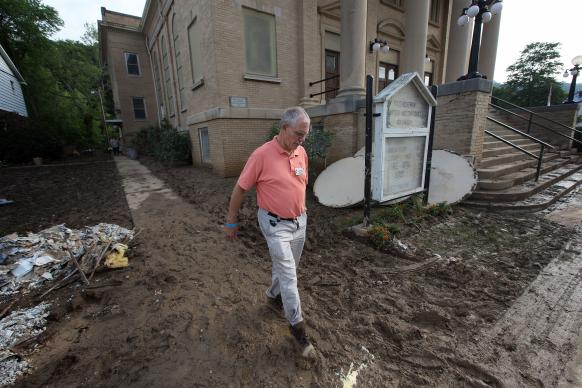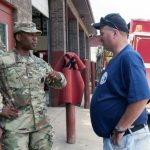By: Sam Hodges | Posted: June 28, 2016 | Source: The United Methodist Church
The Rev. Scott Ferguson was away on vacation when the floods hit Clendenin, West Virginia, last week. When he finally got a look at the parsonage of Clendenin United Methodist Church, he realized he and his wife wouldn’t be staying there for a while longer.
“We took about three and a half feet of water in our home,” Ferguson said. “Everything downstairs is lost.”
But he’s made progress with mud removal, and he’s determined that he and his congregation will stay the course spiritually during a hard time.
“We just want to make sure God is praised even through the storm,” he said.
Last week, parts of West Virginia saw 9 inches of rain in a matter of hours, causing some of worst flooding the state has seen in three decades. The floods claimed 23 lives and damaged or destroyed thousands of homes. Some residents remain without power.
West Virginians are still in awe of the epic downpour.
“The amount of rain was just unimaginable,” said the Rev. J.F. Lacaria, director of connectional ministries for the West Virginia Conference.
United Methodists are helping with relief efforts in various ways, including churches that served as shelters first, and then became donation and distribution centers.
But in the hardest-hit communities, such as Clendenin, on the Elk River in south central West Virginia, and White Sulphur Springs and Rainelle, in the southeastern part of the state, churches are dealing with their own losses.
A related fatality occurred within Clendenin United Methodist Church. A member died, apparently of a heart attack, while shoveling mud after the heavy rain, Ferguson said.
Along with damage to the parsonage, Clendenin United Methodist Church itself took on several feet of water in the basement.
“Everything in that basement is going to have to come out,” Ferguson said. “We lost everything in our kitchen. We lost everything in our fellowship hall. We lost everything in our nursery … The Boy Scouts lost everything in their room.”
Ferguson also leads Brawley Chapel United Methodist Church, a smaller church right on the Elk River. Its foundation, eroded by the floods, continues to move.
“It won’t be long before it’s in the river,” Ferguson said of the church. “It’s a complete loss.”
Churches serve as relief centers
Emmanuel United Methodist Church, in White Sulphur Springs, was spared severe flooding damage, and has become a major center for distribution of relief items.
“We’ve got buckets, we’ve got water, we’ve got food, we’ve got paper towels,” said the Rev. Shari Stilgenbauer, pastor. “We’ve even got pet food and kitty litter.”
White Sulphur Springs saw some of the worst flooding, to the point that next week’s Greenbrier Classic PGA tournament at the local Greenbrier Resort has been canceled.
Stilgenbauer said home damage is widespread.
“More have massive damage. … It’s devastating, and that’s putting it mildly. We have a couple of little communities – things are just gone. We have a trailer park that’s basically wiped out.”
Rainelle is another southeastern West Virginia community that was badly hurt by the floods. The Rainelle United Methodist Church – made entirely of American chestnut before blight removed that tree from the landscape — had some damage but has served as a donation center, Lacaria said.
Early response teams from local United Methodist churches are beginning to help with relief work.
“They’re just moving to the muck-out phase,” Lacaria said.
The New Vision Depot, a West Virginia Conference facility in Beaver, West Virginia, has volunteers distributing clean-out buckets and health kits.
Conference prepared for disaster
The West Virginia Conference was well prepared to deal with this emergency, said Greg Forrester, who coordinates U.S. disaster response for the United Methodist Committee on Relief and has worked directly with the Rev. Dan Lowther, the conference disaster response coordinator.
“We did a capacity building grant with them so they could actually do training with all of their district disaster response coordinators,” Forrester said. “That happened about six weeks ago.”
Those district coordinators, he added, “have been mobilized since the storm.”
The Rev. Jeffrey Allen is a United Methodist elder who serves as executive director of the West Virginia Council of Churches, an ecumenical group that responds to disasters.
“We’ve identified five staging areas across the state where we are deploying clergy to provide pastoral support to persons who have been impacted by the flood and first responders,” Allen said.
Stilgenbauer was cheered by both the organized and ad hoc relief efforts she was seeing in her area.
“The community is pulling together in ways I’d never imagined,” she said.
Forrester stressed that the conference currently is not hosting early response volunteers from outside the state. Donations through UMCOR in response to the West Virginia flooding can be made to the agency’s U.S. disaster response fund.
West Virginia Conference Bishop Sandra Steiner Ball wrote a prayer prompted by the flooding, and it’s posted on the conference website. It begins:
“Oh God, hold your children of West Virginia in your strong arms once again. You know the loss, the crisis, the chaos, the pain that is being experienced by those affected by storm and flood. In the midst of this adversity, please be very present with the families and the communities who have been devastated and are searching for things and for answers.”
Hodges, a United Methodist News Service writer, lives in Dallas. Contact him at (615) 742-5470 or newsdesk@umcom.org
Linda Bloom of UMNS and the Rev. Deborah Coble of the West Virginia Conference contributed.








